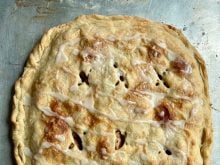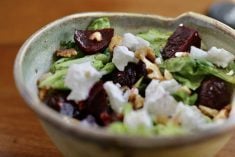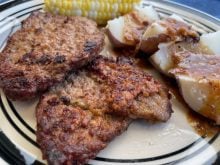Fishing may be one of your dad’s favourite sports and if so, count yourself lucky. I was fortunate to have grown up on fresh-caught lake fish. It was on regular rotation at our dinner table.
Fish, both lean and oily, are heart-healthy choices but the two require different cooking methods.
When selecting fish to deep fry, make sure it’s a neutral-tasting type that isn’t too oily. Cod, catfish, shrimp, halibut and tilapia are among the most common types that have excellent texture and flavour when fried.
Read Also

Vintage power on display at Saskatchewan tractor pull
At the Ag in Motion farm show held earlier this year near Langham, Sask., a vintage tractor pull event drew pretty significant crowds of show goers, who were mostly farmers.
If you have never had ceviche, you’ve been missing out. It is a Latin American dish in which firm and semi-firm fish is cut into cubes and “cooked” using acid from citrus, like lime. Some of the best types of fish for ceviche are cod, scallops, walleye, northern pike and sole. I find that an oily fish, such as steelhead trout or salmon, adds a stronger flavour that detracts from its delicacy.
When choosing fish to grill, select something thick and hardy like salmon, swordfish or mahi-mahi. Thinner fish won’t withstand the heat of the grill and will fall apart when you try to remove it. A whole fish, skin on, is perfect for grilling. If you want to add more depth of flavour, grill the fish on cedar planks. Thinner and more delicate fish can also be successfully grilled on a cedar plank.
There are many methods to freeze fish before packaging it for sale. Look for these labels: Frozen at Sea (FAS) or Individually Quick-Frozen (IQF). The freshest technique is FAS because it means the fish is caught, filleted and frozen on the boat almost immediately.
If thawing a fatty fish like salmon or steelhead trout, it is a good idea to place it in the refrigerator a few hours or overnight before cooking it, as opposed to defrosting it on the counter.
Thinner, flakier white fish like pickerel, cod, haddock or halibut can be cooked right from the freezer. Just lightly coat the fish in olive oil, sauté for about four minutes and remove it from the stove. Sprinkle the fish with salt and breadcrumbs or your favourite condiment and place it in the oven for a few more minutes to finish cooking.
Crispy Fried Fish
Be sure the oil is up to temperature and don’t crowd the pot or the temperature will drop quickly. The fish won’t cook properly and it will be oily. Draining on a rack rather than paper towels is important to keep the fish crispy.
Dredge:
- 1/2 c. all-purpose flour 125 mL
- 1 tsp. kosher salt 5 mL
- 1/2 tsp. black pepper 3 mL
Batter:
- 1 c. all-purpose flour 250 mL
- 1 tsp. onion powder 5 mL
- 1 tsp. garlic powder 5 mL
- 1/2 tsp. crushed red pepper 3 mL
- 3/4 tsp. baking powder 4 mL
- 3/4 tsp. ground turmeric, optional 4 mL
- 3/4 tsp. black pepper 4 mL
- 1/2 tsp. kosher salt 3 mL
- 1 large egg, slightly beaten
- 1 c. cold beer orclub soda 250 mL
Additional Ingredients:
- 3 c. canola oil,approximately 750 mL
- 1 lb. skinless firm white fish like northern pikeor cod 500 g
- 1 1/2 tsp. kosher salt 8 mL
- 3/4 tsp. black pepper 4 mL
To make the dredge, whisk together flour, salt and black pepper in a large bowl until well combined.
Make the batter by whisking together flour, onion powder, garlic powder, baking powder, black and red pepper flakes, salt and sugar in a large, shallow bowl until well combined. Just before frying the fish, whisk in beer or club soda until well combined.
Heat oil in a 10-inch (25 cm) straight-sided skillet or Dutch oven to 375 F (190 C). Season fillets evenly with one teaspoon salt (5 mL) and 1/2 teaspoon (3 mL) black pepper.
Place two fillets in dredge mixture, pressing mixture onto fillets. Gently shake off excess. Dip fillets in batter, allowing any excess batter to drip off. Carefully place battered fillets in hot oil, and cook, turning occasionally, until golden brown and cooked through, three to four minutes. Transfer fillets to a wire rack set inside a rimmed baking sheet. Season pieces of fish with salt and black pepper. Repeat frying process with remaining fillets, salt, and pepper. Serve with fries and tartar sauce.
Red Cabbage Slaw
- 8 c. thinly slicedred cabbage 2 L
- 1/4 red onion
- 1/2 c. mayonnaise 125 mL
- 2 tbsp. apple cidervinegar 30 mL
- 2 tbsp. sugar or honey 30 mL
- 1/2 tsp. celery seeds 3 mL
- 1 tsp. kosher salt 5 mL
- fresh ground black pepper
Thinly slice red cabbage. Thinly slice onion into slivers. In a large bowl, whisk together the mayonnaise, apple cider vinegar, sugar, celery seeds, salt and fresh ground black pepper.
Add the cabbage and red onion and toss to combine. Refrigerate until served. It will be just as nice the next day.
Poached fish
Any type of fish can be prepared by poaching.
- 1/2 c. white wine 125 mL
- 1/2 medium onion, sliced
- 2 cloves garlic, crushed
- 1/2 lemon, sliced
- 1/2 tsp. sea salt 3 mL
- fresh herbs such as tarragon, oregano or chives, optional
- sliced onions, carrots and celery, optional
- whole rainbow trout, or any whole fish or fillet
Put all the ingredients, except the fish, in a heavy roasting pan and add at least two inches (5 cm) of water. Heat the water over medium heat until it is steaming, the water is moving around but not bubbling. You should be able to dip your finger into the water very briefly without burning it. Reduce the heat to medium-low.
Once the water is hot, slide the fish into the pan. If there is not enough water to cover the fish, add a little more. The trick here is that you want the water to remain at a temperature where it is not boiling but very hot. Poaching does not use boiling water.
The fish is ready when the flesh flakes easily from the fish. A salmon fillet will take approximately 10 minutes to poach. The poaching time will vary depending on the thickness of the fish. Remember that the water should not boil and overcook your fish.
Carefully remove the fish from the poaching liquid using a slotted spatula and serve it immediately. This can also be chilled and served cold.
Planked salmon
- individual pieces or a fillet of salmon
- canola or olive oil
- maple syrup
- lavender buds
- sea salt, freshly ground black pepper
- cedar plank
Drizzle the salmon with oil and maple syrup and season with the salt, pepper and lavender buds.
Oil the plank and preheat at high heat on the barbecue or in a 400 F (200 C) oven. When the board is smoking, remove from heat and place the salmon on it, skin side down. Return to heat and continue to bake until the fish flakes easily. Serve immediately.
Sarah Galvin is a home economist, teacher and farmers’ market vendor at Swift Current, Sask., and a member of Team Resources. She writes a blog at allourfingersinthepie.blogspot.ca. Contact: team@producer.com.

















